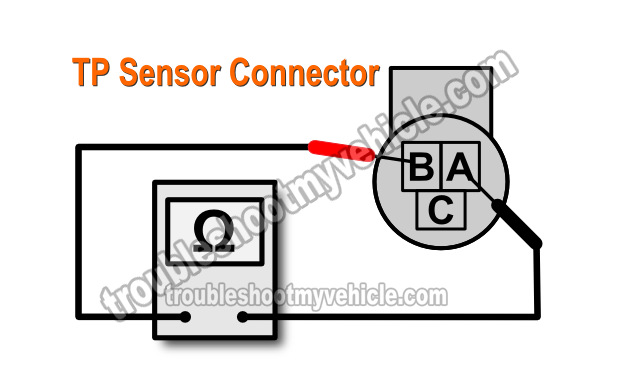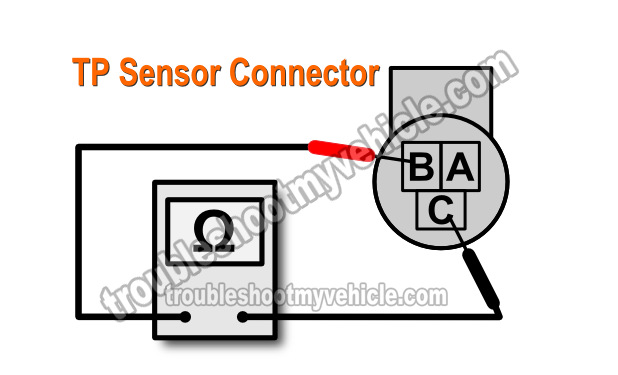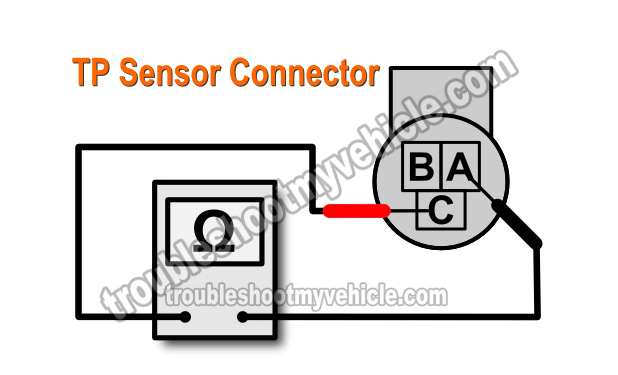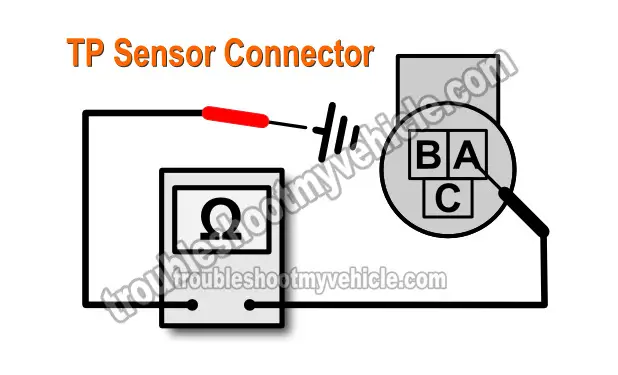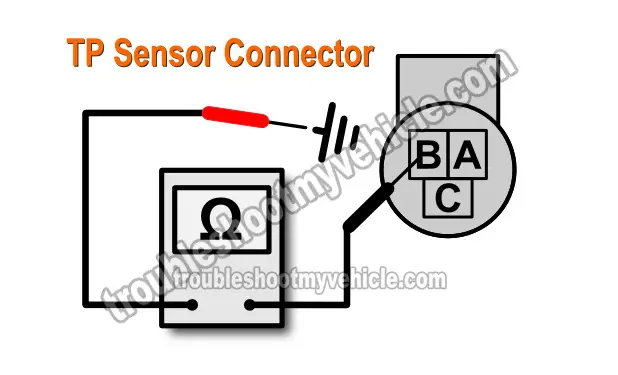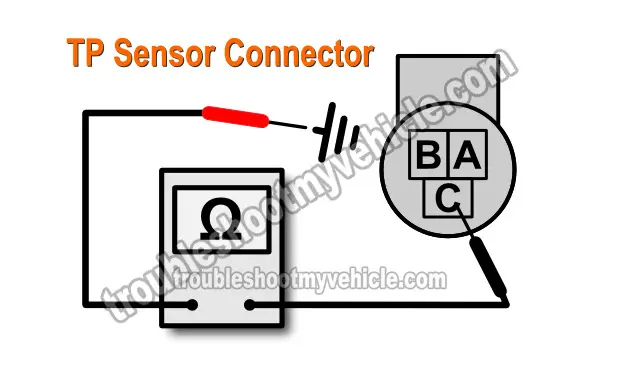TEST 2: Circuits Shorted To Each Other
So far you have checked and confirmed that all 3 of the throttle position sensor (TPS) wires have continuity between them and the PCM (TEST 1).
The next troubleshooting step is to make sure that the TPS wires are not shorted to each other somewhere in the engine's wiring harness.
The cool thing is that we don't have to tear apart the wiring harness to physically check to see if the wires are shorted together or not.
How can we check to see if the wires are shorted to each other? By doing several continuity test between the wires (since there should not be any continuity between them) with your multimeter in Ohms mode.
These are the test steps:
- 1
Disconnect the battery from its negative cable. This will ensure that no circuit is 'live' with power before proceeding to the next step.
- 2
Make sure the PCM is disconnected from its 2 connectors before proceeding to step 3.
- 3
Check the continuity of throttle position sensor (TPS) connector terminals B and A with your multimeter in Ohms (Ω). See image 1 of 3.
Your multimeter should register OL (Open Loop) and NOT register continuity. - 4
Check the continuity of throttle position sensor (TPS) connector terminals B and C with your multimeter in Ohms (Ω). See image 2 of 3.
Your multimeter should register OL (Open Loop) and NOT register continuity. - 5
Check the continuity of throttle position sensor (TPS) connector terminals C and A with your multimeter in Ohms (Ω). See image 3 of 3.
Your multimeter should register OL (Open Loop) and NOT register continuity.
Let's take a look at what your test results mean:
CASE 1: None of the throttle position sensor (TPS) wires were shorted together. This is the correct and expected test result. Your next step is to make sure none of the throttle position sensor (TPS) wires are shorted to Ground. For this test, go to: TEST 3: Checking For Shorts To Ground.
CASE 2: One or more of the throttle position sensor (TPS) wires were shorted together. Make sure that the PCM is disconnected from its two connectors.
If the PCM is unplugged from its two connectors, then this test result tells you that you have a problem in the wiring since the multimeter should have NOT registered continuity.
Repairing the shorted throttle position sensor (TPS) wires will solve the throttle position sensor (TPS) problem and trouble codes.
TEST 3: Checking For Shorts To Ground
In this test step, we're gonna' make sure that none of the 3 throttle position sensor (TPS) wires are shorted to Ground.
This test can also be accomplished with a few simple multimeter continuity tests between the specific TPS wire, you're testing, and chassis Ground.
NOTE: The chassis Ground point you choose needs to be a clean rust and paint free spot on the engine or intake manifold.
These are the test steps:
- 1
The PCM, the battery negative (-) terminal, and the automatic transmission must remain disconnected to accomplish the next test steps.
- 3
Check the continuity of throttle position sensor (TPS) connector terminals A and Ground with your multimeter in Ohms (Ω) mode. See image 1 of 3.
Your multimeter should register OL (Open Loop) and NOT register continuity. - 4
Check the continuity of throttle position sensor (TPS) connector terminals B and Ground with your multimeter in Ohms (Ω). See image 1 of 3.
Your multimeter should register OL (Open Loop) and NOT register continuity. - 5
Check the continuity of throttle position sensor (TPS) connector terminals C and Ground with your multimeter in Ohms (Ω). See image 3 of 3.
Your multimeter should register OL (Open Loop) and NOT register continuity.
Let's take a look at what your test results mean:
CASE 1: None of the throttle position sensor (TPS) wires are shorted to Ground. This is the correct and expected test result and it's looking like you just might have a bad PCM on your hands.
There's still one more set of tests you should do and it's to make sure that the PCM has power and Ground. For these tests, go to: TEST 4: PCM Power And Ground Tests.
CASE 2: One or more of the throttle position sensor (TPS) wires were shorted to Ground. Make sure that the PCM and the automatic transmission are disconnected from their connectors.
If the PCM and automatic transmission (4L60-E) are unplugged from their connectors, then this test result tells you that you have a problem in the wiring since the multimeter should have NOT registered continuity.
Repairing the shorted throttle position sensor (TPS) wires will solve the throttle position sensor (TPS) problem and trouble codes.

